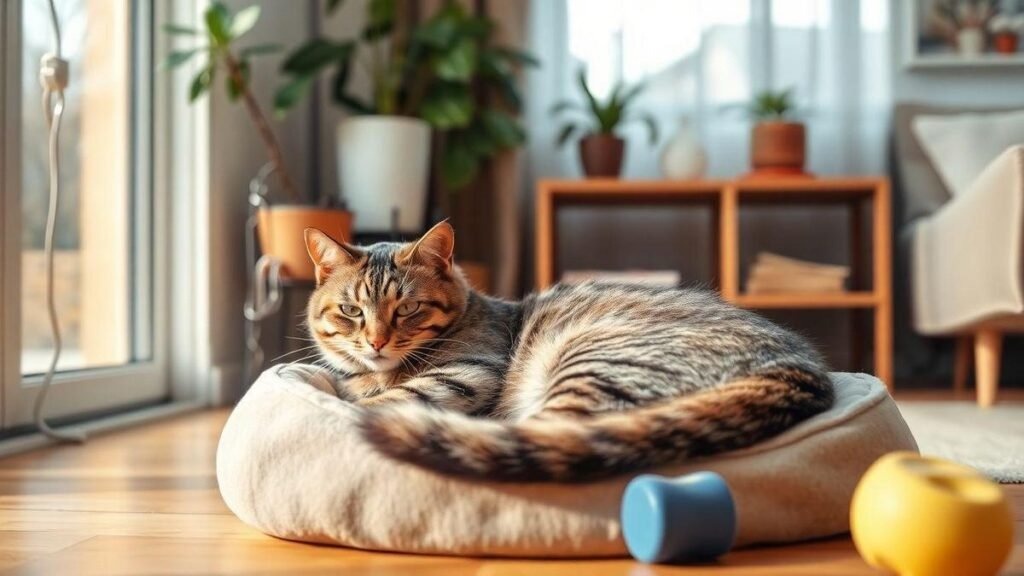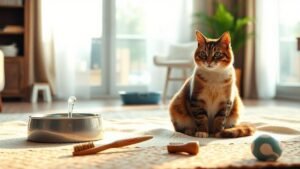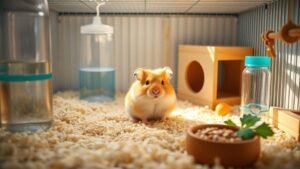How I make a safe home for cats — Como fazer um ambiente seguro para gatos e evitar acidentes
This guide — Como fazer um ambiente seguro para gatos e evitar acidentes — shows my practical, room‑by‑room routine for spotting hazards and fixing them fast. I want my cat to feel safe and happy, so I secure windows and balconies, hide cords, remove toxic plants, store meds and cleaners, anchor furniture, and keep a ready first‑aid kit and vet contacts.

Key takeaway
- Secure windows and balconies with sturdy screens or netting.
- Store cleaners, medicines, and human food out of reach.
- Hide or cover electrical cords and small objects that can be swallowed.
- Supervise outdoor time or use a harness and leash.
- Offer safe toys and regular play to reduce risky behavior.
How I inspect my home (room by room)
I walk through each room like a detective: scanning for loose cords, open windows, small objects, and hazardous plants. I note repeat problems and fix them immediately. Quick actions after a close call (like covering a chewed charger) stopped risks fast.
Room checklist
| Room | Common hazards I check | Quick fixes I use |
|---|---|---|
| Living room | Cords, small decor, candles | Cord covers, remove small items, flameless candles |
| Kitchen | Cleaners, open trash, food on counters | Lock chemicals, lidded trash cans, sealed food containers |
| Bedroom | Loose strings, windows | Tie curtains, install secure screens |
| Bathroom | Meds, shampoos, toilet lid | Lock meds, close cabinet doors, keep lid down |
| Balcony | Gaps, planters, railings | Install netting, move pots inside, remove dangling items |
I keep this plan on my phone and tick off each fix.
Simple home safety checklist
- Hide all cords near floor level.
- Store toxic items in high or locked cabinets.
- Secure windows and balconies with screens or netting.
- Use lidded trash cans and childproof cabinet latches.
- Replace candles with flameless versions.
- Remove small objects (rubber bands, twist ties).
- Swap risky plants for cat‑safe species.
- Keep a first‑aid kit and vet contact info handy.
How I secure windows and balconies — part of Como fazer um ambiente seguro para gatos e evitar acidentes
Fresh air is great, but I follow clear steps so outdoor views don’t become accidents.
Screens, nets and guards
I use tear‑resistant materials (metal mesh, heavy nylon) and check for any gaps bigger than a fingernail. Test installations gently; if it moves, reinforce it. For detailed ideas on safe balcony and window setups I often consult guides on how to build a cat-safe balcony or window perch and options for non-invasive window mounts like building a window perch without drilling.
| Option | Best for | Pros | Cons |
|---|---|---|---|
| Metal mesh | High‑traffic windows | Strong, chew‑resistant | Heavier to install |
| Pet net | Balconies, open railings | Lightweight, flexible | Needs secure anchoring |
| Plexiglass guard | Low rails/windows | Solid barrier, easy to clean | Slightly blocks view |
I also use window restrictors so openings are only a few inches, and I never leave my cat alone on a balcony. I trained my cat to wear a harness for supervised outdoor time and learned helpful transition tips from resources about keeping indoor cats happy without letting them out.
Safe installation tips:
- Measure carefully before buying.
- Use strong anchors and recheck monthly.
- Cover any gaps under 1 cm with weatherstripping.
- Keep tools away from curious paws during work.
Preventing poisoning — essential part of Como fazer um ambiente seguro para gatos e evitar acidentes
I remove toxic plants, lock away medicines, and keep human food sealed. New items get checked before ever entering the home.
Weekly poison‑prevention checklist
- Move risky plants to high shelves or give them away.
- Put medicines in a locked drawer.
- Store human food in closed containers.
- Label all bottles clearly.
For safe plant swaps I reference lists of plants safe for homes with cats and dogs and ideas for a controlled indoor garden such as a DIY indoor cat garden to keep greenery within reach but risk‑free.
| Item | Why it’s risky | Safe swap / Action |
|---|---|---|
| Lilies | Kidney failure in cats | Remove or replace with cat‑safe plants (e.g., spider plant) |
| Chocolate | Toxic to cats | Keep sweets in sealed cabinets |
| Grapes/Raisins | Kidney damage | Avoid table scraps |
| Pain meds (acetaminophen, ibuprofen) | Can be deadly | Store in locked box away from pets |
| Antidepressants | Severe reactions | Childproof containers locked drawer |
Pet‑safe cleaning:
- Use plain vinegar or vet‑approved cleaners.
- Avoid bleach, phenols, and essential oils harmful to cats — consult guidance on safe essential oil use around pets.
- Label sprays: “PET – DO NOT USE NEAR FOOD.”
Emergency poison steps:
- Remove the cat from the source and wipe fur with a damp cloth.
- Call your vet or emergency clinic immediately. In the U.S., ASPCA Poison Control: 888‑426‑4435.
- Have the product label ready.
- Do not induce vomiting unless instructed by a professional.
- Keep a towel and carrier ready for transport.
For staying safe during household chores and cleaning, I follow best practices from guides about keeping pets safe during cleaning.
Electrical cords, heavy items and other common hazards
Cords and unstable items are frequent causes of injury—simple fixes prevent most problems.
Cord safety
I hide or cover cords with cord protectors, PVC tubing, or cord channels, and use a vet‑safe bitter spray if needed. Raise cords off the floor and tuck them behind furniture. Replace warm or damaged cords immediately.
| Hazard | What I do | Why it works |
|---|---|---|
| Chewing cords | Cord protectors, bitter spray | Protects mouth and prevents shocks |
| Dangling cords | Shorten or clip up | Removes play targets |
| Loose plugs | Hide or use covers | Lowers chewing/pulling risk |
Outlet and power safety:
- Use childproof outlet plugs.
- Enclose power strips in ventilated boxes.
- Coil and clip cords along baseboards with adhesive clips.
Securing furniture and small items
I anchor tall furniture with straps, put heavy items low, and keep small objects (batteries, magnets, rubber bands) in closed bins. Check floors daily and design spaces following principles from articles on creating a pet‑friendly indoor space.
Preventing indoor injuries: toys, play and soft landings
Following Como fazer um ambiente seguro para gatos e evitar acidentes includes changing how I play and what toys I allow.
Toys and play rules
I choose sturdy toys without loose beads or threads, supervise wand play, and store strings after each session. For toy ideas and safe options I often look at recommendations for the best indoor cat toys and DIY play ideas like cardboard playgrounds or DIY cat tunnels.
| Safe toys I use | Why | Unsafe I avoid |
|---|---|---|
| Soft stuffed mice (sewn eyes) | No small parts | String, ribbon, yarn |
| Rubber balls (no holes) | Hard to chew through | Toys with loose beads |
| Interactive puzzle feeders | Mental stimulation | Small plastic pieces |
Rules:
- Remove toys with threads or small parts immediately.
- Supervise risky play each session.
- Rotate and inspect toys weekly.
Soft landings & anchored furniture
I place soft pads under high perches, use cushions and rugs, anchor shelves, and move heavy items to lower levels. To expand vertical space safely, I follow training and build tips from resources on training cats to use indoor climbing shelves and building a cat wall.
Cleaning, maintenance and a quick daily routine to support Como fazer um ambiente seguro para gatos e evitar acidentes
I use pet‑safe cleaners, store chemicals in a locked box, and run a 5‑minute safety check each morning.
Cleaners to avoid and safe alternatives
| Cleaner to avoid | Why risky | Safe alternative |
|---|---|---|
| Bleach | Burns paws, toxic if licked | Diluted white vinegar (where appropriate) |
| Pine/citrus cleaners | Phenols/oils harmful | Soap & water or vet‑approved cleaners |
| Essential oil sprays | Breathing/liver issues | Unscented, pet‑safe sprays |
Storage tips: high cabinet or locked box, never leave bottles on counters, wipe spills and ventilate.
First‑aid kit and emergency plan
I keep a compact first‑aid kit, carrier, and printed emergency contacts by the phone. For overall comfort and emergency readiness, I integrate advice from posts on keeping your pet’s environment clean and comfortable and on creating a safe and stimulating indoor space.
First‑aid kit essentials:
- Gauze & bandage tape
- Tweezers
- Hydrogen peroxide (3%) — only use if instructed by vet
- Digital thermometer
- Vet‑approved wound wash
- Blanket & carrier
Emergency plan:
- Save at least two emergency vet numbers (phone paper).
- Practice calm handling and carrier use.
- Teach household members: call vet, contain cat, bring carrier.
My 5‑minute daily safety routine
| Task | What I look for | Time |
|---|---|---|
| Entry & floors | No loose strings or small objects | 1 min |
| Windows & balcony | Screens secure, doors locked | 1 min |
| Counters & tables | No bottles, food, or dangling cords | 1 min |
| Plants & trash | Toxic plants removed, lids closed | 1 min |
| Carrier & meds | Carrier visible, meds stored | 1 min |
I talk calmly to my cat while I check; the routine soothes both of us. For extra tips on helping a cat settle into a new routine or space, I refer to posts about helping a cat adjust to a new apartment and supporting a recently adopted rescue cat.
Conclusion
Small, steady actions create a strong safety net. Como fazer um ambiente seguro para gatos e evitar acidentes means: check each room, secure windows and balconies, cover cords, remove toxic plants, and keep a ready first‑aid kit and vet numbers. My 5‑minute morning routine and a room‑by‑room plan stop most accidents before they start. It’s not perfection — it’s preparation, calm action, and love. For more ways to build safe, enriching spaces and vertical options for active cats, see ideas on creating vertical climbing spaces and on making indoor spaces safe and stimulating.
Frequently Asked Questions
Q: How do I make my home safe for my cat fast?
A: Remove loose cords, tuck them away, lock cabinets with cleaners and meds, secure windows and balconies with screens or netting. Following Como fazer um ambiente seguro para gatos e evitar acidentes means focusing on the highest‑risk areas first — see practical balcony and window options like building a cat-safe balcony or window perch.
Q: What common things hurt indoor cats?
A: Chewing cords, toxic plants, small swallowable objects, open windows, and uncovered trash are the most common hazards. Clear these from reach and replace risky plants with choices from lists of cat‑safe plants.
Q: How can I stop my cat from falling out a window or off a balcony?
A: Install secure screens, nets, or guards; use window restrictors; never leave cats unattended on balconies; supervise with a harness if needed and train transitions using tips from keeping indoor cats happy without letting them out.
Q: Which foods and plants should I hide from my cat?
A: Hide lilies, poinsettias, chocolate, grapes/raisins, onions, garlic, and any foods high in xylitol. Replace risky plants with cat‑safe alternatives and consult your vet if unsure; gardening ideas for safe plants are available in a DIY indoor cat garden guide.
Q: What do I do if my cat gets hurt at home?
A: Stay calm, check breathing and bleeding, call your vet or emergency clinic immediately, have product labels ready if poisoning is suspected, and transport the cat in a carrier.
Want more practical tips and real stories about Como fazer um ambiente seguro para gatos e evitar acidentes? Visit https://blogcraelo.com.






